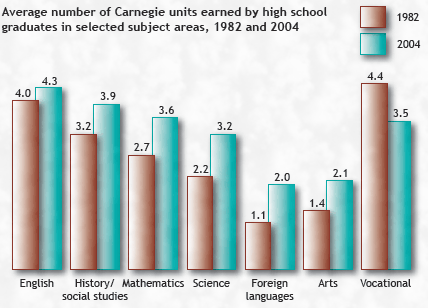|
High school students take courses in core
subject areas at a greater rate now than two decades ago,
according to a recent study by the U.S. Department of
Education.
Core subjects are those that make up a
required part of most college curriculums. According to
"High School Coursetaking: Findings from the
Condition of Education," a 2007 report from the
National Center for Education Statistics, 2004 high school
graduates had taken more courses in core subject areas
than 1982 graduates had. The overall number of course
credits that students earned—measured in Carnegie units,
a standardized tally of
instruction time—was also higher for 2004 graduates. At
the same time, participation in vocational education
showed significant declines from 1982 levels.

As the chart shows, the numbers of courses
taken in science, foreign languages, and mathematics increased most over the period. Strong gains in
mathematics were driven by a jump in the number of credits
taken in algebra and higher mathematics.
For more information about high school coursetaking,
write to the National Center for Education Statistics,
1990 K Street NW., Washington, D.C. 20006, or call (202)
502-7300. You may also view the report online at
www.nces.ed.gov/pubs2007/2007065.pdf.
|
As educators can attest, science is
sometimes a tough sell. But free videos, posters, and
other information from the Government can help
educators close the deal.
The National Institutes of Health (NIH)
Office of Science Education offers products and
information that promote science careers. Some
materials encourage young women to consider careers in
medical and health sciences: Videos portray women
surgeons, pathologists, and researchers, and colorful
posters and a Web site depict women who work in
neuroscience, heart disease, and cancer research.
Materials for other audiences include curriculum supplements for K-12 teachers and a career-exploration
Web site for middle school and high school students,
counselors, and parents.
To learn more about these free
products, call (301) 402-2469. To order online, visit
science.education.nih.gov.
 Top Top
|
|
|
|
|
|
|
|
|
U.S. workers—including those in services—are
becoming more productive. Data from the U.S. Bureau of Labor Statistics (BLS) show a rise in labor productivity in
two-thirds of the service-providing industries measured between
2004 and 2005.
Increased labor productivity shows how much more
workers produce per hour; in service-providing industries specifically, it is the value of services provided by the
industries divided by the worker hours in those industries. Productivity increases as industries and workers
become more efficient, meaning that they can accomplish more
work in the same amount of time.
Many factors influence how much workers produce,
including technological change, new machinery, and the ways in
which work is organized and managed. Between 2004 and 2005,
wireless telecommunications carriers, travel agencies, and
photofinishing services experienced the greatest productivity
gains.
For more information, write to the BLS Office
of Productivity and Technology, Suite 2150, 2 Massachusetts
Avenue NE., Washington, D.C. 20212; call
(202) 691-5600; or visit www.bls.gov/lpc/home.htm.
For a PDF version of the news release online, see
www.bls.gov/news.release/archives/prin_06082007.pdf.
 Top Top
|
|
|
|
|
|
|
|
If you’re looking for a scholarship, check out
what’s available from Junior Achievement.
Junior Achievement Worldwide and its sponsors
provide scholarships for a variety of students. Some
scholarships grant tuition and more to students who plan to
attend a specific school or major in a particular subject.
Others award high achievers preparing for any field of study.
Still others are based on financial need.
Applicants usually must provide transcripts and
other documentation, such as college-admissions test scores.
Many of the scholarships also require submission of an essay on
topics ranging from the importance of ethics in business to the
influence of one person in the applicant’s life.
Junior Achievement Worldwide is a nonprofit
organization that promotes understanding of global business and economics. In addition to scholarships available at the national
level, other scholarships might be offered through local Junior
Achievement offices.
To learn more about these scholarships, write to Junior
Achievement Worldwide, One Education Way, Colorado Springs,
Colorado 80906; call (719) 540-8000; or visit online at
www.ja.org/files/programs/programs_schol.shtml.
 Top Top
|
|
|
|
|
|
|
|
Computers are crucial in the information age.
That’s especially true in the workplace.
Many occupations today require the use of
technology, and the U.S. Department of Labor gives specifics
about those requirements. O*Net, the Department’s Occupational
Information Network, gathers information about the types of
software, machines, equipment, and tools that workers use. These
data are called T2, or Tools and Technology, and are made
available for more than 250 in-demand occupations through O*Net
OnLine.
Knowing the kinds of technology that workers
might use helps jobseekers to better prepare for careers, helps
educators to better train workers, and helps employers to better
assess job candidates’ skills. Technology requirements are
assigned broadly, however, so users should remember to fully
research the occupations that interest them.
Tools and technology data are available within
the O*Net occupational profiles through O*Net OnLine. For more
information, visit online.onetcenter.org/help/t2.
 Top Top
|
|



